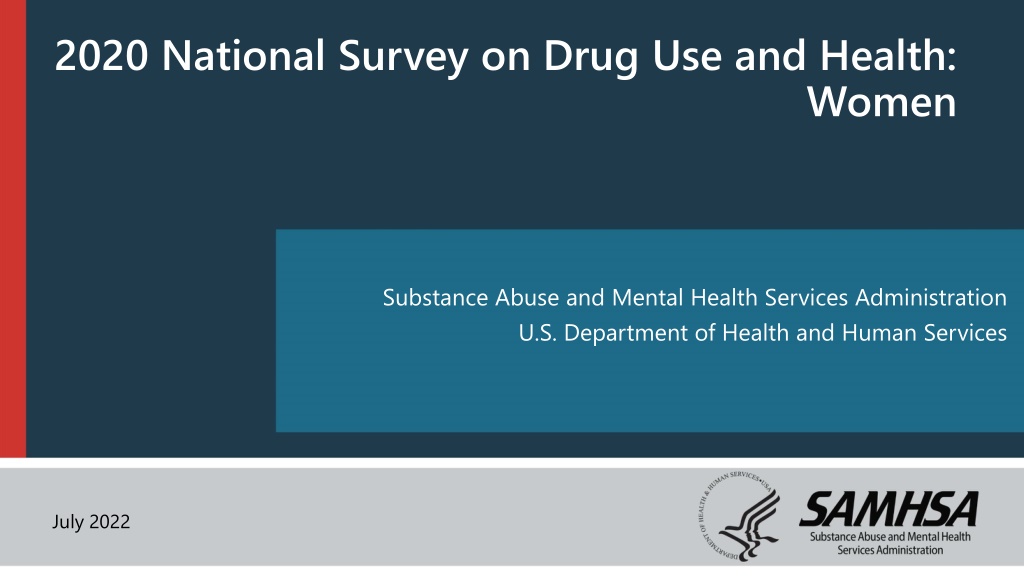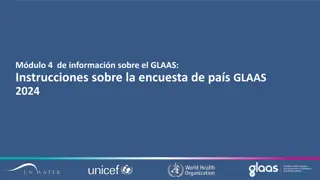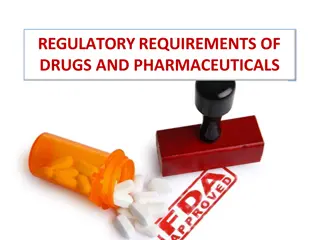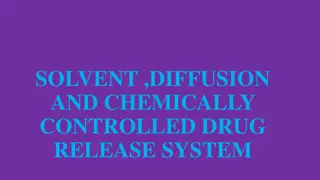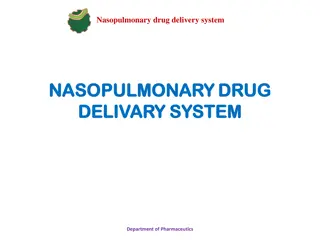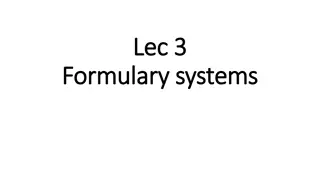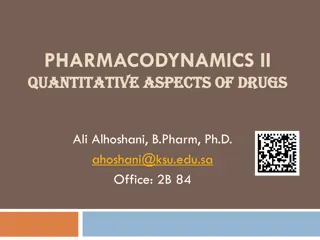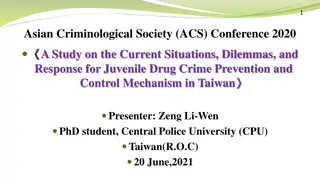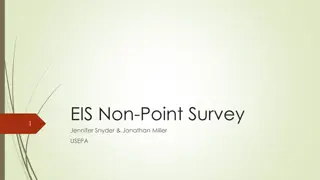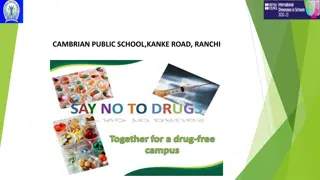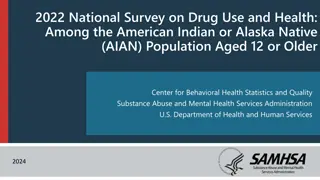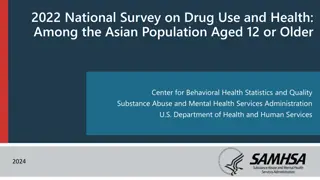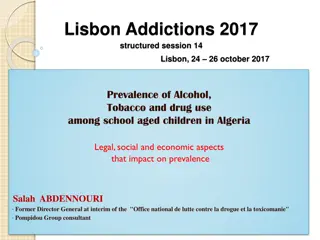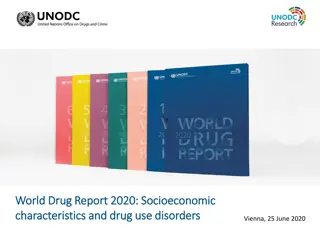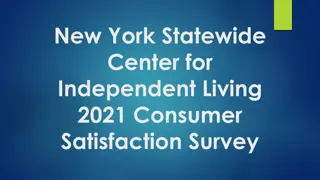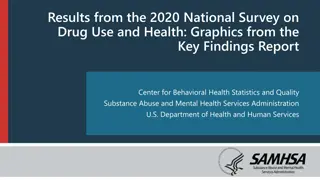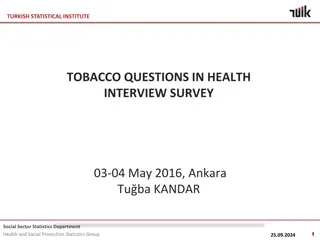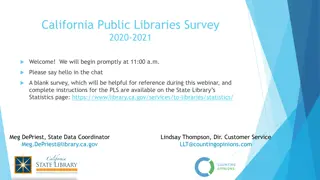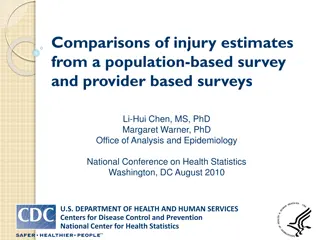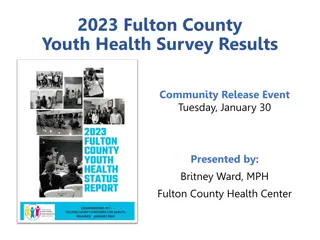Insights from 2020 National Survey on Drug Use and Health
The 2020 National Survey on Drug Use and Health (NSDUH) provides extensive data on substance use, mental health, and treatment services in the United States. It covers various populations but excludes children under 12 and institutionalized groups. The survey offers valuable information for decision-making and policymaking to address substance use issues, mental illness, and their intersection. Changes in 2020 included new data collection methods and content additions related to vaping, telehealth, and COVID-19 impacts.
Download Presentation

Please find below an Image/Link to download the presentation.
The content on the website is provided AS IS for your information and personal use only. It may not be sold, licensed, or shared on other websites without obtaining consent from the author.If you encounter any issues during the download, it is possible that the publisher has removed the file from their server.
You are allowed to download the files provided on this website for personal or commercial use, subject to the condition that they are used lawfully. All files are the property of their respective owners.
The content on the website is provided AS IS for your information and personal use only. It may not be sold, licensed, or shared on other websites without obtaining consent from the author.
E N D
Presentation Transcript
2020 National Survey on Drug Use and Health: Women Substance Abuse and Mental Health Services Administration U.S. Department of Health and Human Services July 2022 1
About This Presentation The estimates in these slides have been rounded for the purposes of presentation. Any appearance of estimates not summing exactly to a known total are due to this rounding. Some slides present the same analysis across multiple years. The underlying populations from which these estimates are derived change across years since the number of people in the United States changes across years. Thus, a change in proportions does not equal a constant change in the weighted count. 2
National Survey on Drug Use and Health (NSDUH) NSDUH is a comprehensive household interview survey of substance use, substance use disorders, mental health, and the receipt of treatment services for these disorders in the United States. NSDUH covers the civilian, noninstitutionalized population, aged 12 or older: Includes: Households, college dorms, homeless in shelters, civilians on military bases Sample includes all 50 states and DC 3
Who is Not Covered by NSDUH? Children under age 12 Populations with potential serious mental health/substance use issues: Institutionalized populations: Incarcerated Hospitalized Nursing homes Homeless populations not in homeless shelters 4
How Do We Use NSDUH? Provides a window into the state of substance use and mental health issues in the United States Provides insights that can be studied in the context of data from other agencies to help in decision-making about what types of resources are needed and where resources should be directed Helps to guide policy in addressing: Problematic substance use Prevalence of mental illness The intersection of substance use and mental health issues State-level treatment and prevention needs by providing data at the state level 5
Changes to NSDUH in 2020 Data typically collected from January to December; collected in Q1 and Q4 only during 2020 Changed to multi-mode collection in Q4 of 2020: web survey added Change from DSM-IV to DSM-5 impacted SUD estimates New and expanded item content: nicotine vaping, receipt of telehealth services, adolescent suicide, COVID-19 impacts Approximately 67,500 persons are interviewed annually; the final 2020 sample consisted of 36,284 completed interviews 6
Mental Illness and Substance Use Disorders in America in the Past Year: Among Women Aged 18+ 7
Summary: Alcohol Use in 2020 Among women aged 12 to 17 in 2020: 9.2 percent (or 1.1 million people) used alcohol in the past month 3.4 percent (or 422,000 people) had an alcohol use disorder Among women aged 18 to 25 in 2020: 52.1 percent (or 8.7 million people) used alcohol in the past month 16.6 percent (or 2.8 million people) had an alcohol use disorder Among women aged 26 or older in 2020: 51.1 percent (or 58.0 million people) used alcohol in the past month 8.3 percent (or 9.4 million people) had an alcohol use disorder 10
Prescription Pain Reliever Misuse and Heroin Use in Past Year: Among Women Aged 12+ 12
Prescription Pain Reliever Misuse and Heroin Use in Past Year: Among Women Aged 12+ 14
Prescription Pain Reliever Misuse in Past Year: Among Women Aged 12+ 15
Sources Where Pain Relievers Were Obtained for Most Recent Misuse in Past Year: Among Women Aged 12+ Who Misused Prescription Pain Relievers in Past Year 16
Misuse of Prescription Opioid Subtypes in Past Year: Among Women Aged 12+ Who Had Any Use of the Prescription Opioid 17
Summary: Opioid Misuse in 2020 Opioid misuse is primarily driven by prescription pain reliever misuse. Most prescription pain relievers that are misused are obtained from a prescription to the misuser or given to the misuser for free by a friend or relative. Among women aged 12 to 17 in 2020: 1.5 percent (or 181,000 people) misused opioids in the past year 0.3 percent (or 36,000 people) had an opioid use disorder Among women aged 18 to 25 in 2020: 4.5 percent (or 746,000 people) misused opioids in the past year 1.0 percent (or 165,000 people) had an opioid use disorder Among women aged 26 or older in 2020: 3.7 percent (or 4.2 million people) misused opioids in the past year 1.2 percent (or 1.3 million people) had an opioid use disorder 21
Frequency of Marijuana Use: Among Female Youths Aged 12-17 24
Frequency of Marijuana Use: Among Young Adult Women Aged 18-25 25
Marijuana Use Disorder in Past Year: Among Women Aged 12+ 27
Substance Use in Past Month: Among Pregnant Women Aged 15- 44 28
Marijuana Use in Past Month: Among Women Aged 15-44; By Pregnancy Status 29
Daily or Almost Daily Marijuana Use in Past Year: Among Women Aged 15-44; By Pregnancy Status 30
Summary: Marijuana Use in 2020 Among women aged 12 to 17 in 2020: 5.6 percent (or 683,000 people) used marijuana in the past month 4.2 percent (or 512,000 people) had a marijuana use disorder Among women aged 18 to 25 in 2020: 22.7 percent (or 3.8 million people) used marijuana in the past month 11.8 percent (or 2.0 million people) had a marijuana use disorder Among women aged 26 or older in 2020: 9.1 percent (or 10.4 million people) used marijuana in the past month 3.0 percent (or 3.4 million people) had a marijuana use disorder Among pregnant women aged 15 to 44 in 2020: 8.0 percent (or 164,000 women) used marijuana in the past month 31
Misuse of Prescription Stimulants in Past Year: Among Women Aged 12+ 34
Summary: Other Substance Use in 2020 Among women aged 12 to 17 in 2020: 0.1 percent (or 10,000 people) used cocaine in the past year 0.1 percent (or 16,000 people) used methamphetamine in the past year 1.3 percent (or 154,000 people) misused prescription stimulants in the past year 0.8 percent (or 98,000 people) used LSD in the past year Among women aged 18 to 25 in 2020: 1.4 percent (or 231,000 people) used cocaine in the past year 0.7 percent (or 113,000 people) used methamphetamine in the past year 4.5 percent (or 757,000 people) misused prescription stimulants in the past year 3.3 percent (or 551,000 people) used LSD in the past year Among women aged 26 or older in 2020: 0.4 percent (or 433,000 people) used cocaine in the past year 1.1 percent (or 1.2 million people) used methamphetamine in the past year 1.3 percent (or 1.5 million people) misused prescription stimulants in the past year 0.4 percent (or 457,000 people) used LSD in the past year 36
Polysubstance Use and Mental Illness 37
Substance Use in Past Year: Among Women Aged 12+; Major Depressive Episode (MDE) and Serious Mental Illness (SMI) in Past Year: Among Women Aged 18+; By Level of Alcohol Use in Past Month 38
Substance Use in Past Year/Month: Among Women Aged 12+; Major Depressive Episode (MDE) and Serious Mental Illness (SMI) in Past Year: Among Women Aged 18+; By Level of Marijuana Use in Past Year 39
Substance Use in Past Year/Month: Among Women Aged 12+; Major Depressive Episode (MDE) and Serious Mental Illness (SMI) in Past Year: Among Women Aged 18+; By Level of Opioid Misuse in Past Year 40
Substance Use in Past Year/Month: Among Women Aged 12+; Major Depressive Episode (MDE) and Serious Mental Illness (SMI) in Past Year: Among Women Aged 18+; By Level of Methamphetamine Use in Past Year Data not shown low precision 41
Summary Polysubstance use is common if a person is having problems with one substance, they may be having problems with other substances Treatment providers must screen for and treat all substance use disorders and problem substance use Association of substance misuse and mental illness is clear we must all do a better job of helping Americans understand these relationships and risks 42
Serious Mental Illness (SMI) in Past Year: Among Women Aged 18+ 44
Major Depressive Episodes in Past Year: Among Women Aged 12+ 45
Major Depressive Episodes with Severe Impairment in Past Year: Among Women Aged 12+ 46
Major Depressive Episodes with Severe Impairment in Past Year: Among People Aged 12+ 47
Suicidal Thoughts, Plans, and Attempts in Past Year: Among Women Aged 18-49 48
Co-Occurring Mental and Substance Use Disorders 49
Substance Use in Past Year/Month: Among Female Youths Aged 12-17; By Past Year Major Depressive Episode (MDE) status 50
